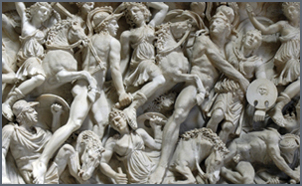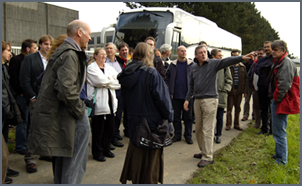Conlfict Archaeologists Meet in the 'Cockpit of Europe'
A report on the Fifth Fields of Conflict conference, Gent & Oudenaarde, 17th to 19th October 2008
Organised jointly by John and Patricia Carman of the University of Birmingham, UK and members of the Ename Center, this three-day meeting of archaeologists interested in the study of warfare in historic periods was a contribution to the year-long commemoration of the tercentenary of the Battle of Oudenaarde. The conference brought the leading conflict archaeologists of the world to a hotel in Ghent to discuss the latest developments in the field, including current research projects, new avenues for research and methodological developments. The 50 conference participants represented seven countries from Europe and elsewhere - Belgium, the UK, Hungary, Germany, Spain, Israel and the USA - as well as a number of members of the ESTOC (European Studies of Terrains of Conflict) group which was founded by John and Patricia Carman at the venue of the Ename Center in Oudenaarde in 2007.
The Fields of Conflict conference - first held in Glasgow, Scotland in 2000 and subsequently every two years in a different location (Finland in 2002, the USA in 2004, England in 2006) - is the leading international gathering of battlefield and conflict archaeologists. Although initially restricted to battlefield archaeology alone, relating to the analysis of bullet scatters left on the landscape - and therefore excluding other aspects related to war and conflict - in 2006 it was agreed to broaden the scope to all aspects of Conflict Archaeology. The conference regularly attracts participation from all parts of Europe and North America.


A high-point of the conference was the day in Oudenaarde. In the splendour of the Town Hall, three presentations gave differing perspectives on the battle of July 11th 1708, followed by three more examining different approaches to issues of remembrance and commemoration. The afternoon was spent partly on the battlefield itself, where participants could see the area of conflict for themselves and gain an insight into the daunting task facing potential investigators of such a large area, by far the biggest battlefield in Europe subject to archaeological investigation: a problem compounded by the range of participants in the battle, from all parts of Europe and using a wide range of weapons with different calibres and bores, making the analysis of any bullet scatters difficult to interpret. The second part of the afternoon was spent in the exhibition Oudenaarde 1708, a City, a King, a General, followed by a reception kindly hosted by Oudenaarde City Council, where the Mayor welcomed conference participants to the city and region.
The presence of the conference in Ghent and Oudenaarde marks the first time such a gathering of international experts in conflict archaeology has met in the so-called 'cockpit of Europe' where so many past disputes between nations have been resolved, from the medieval period to the 20th century. The interest shown in the visit to the battlefield at Oudenaarde reflected the importance of work on the site to the expected future development of Conflict Archaeology. Plans for the publication of the proceedings of the conference are in train, as well as for further archaeological work on the battlefield. Meanwhile, arrangements are also being made for future conferences in the series to be held in Germany and Hungary as well as for a return to the USA.
Back to newsletter
